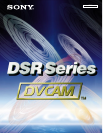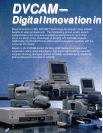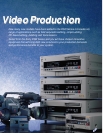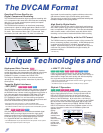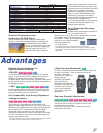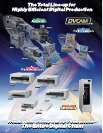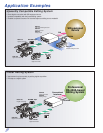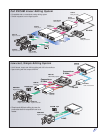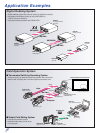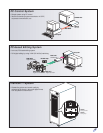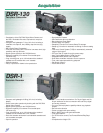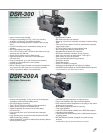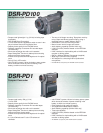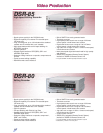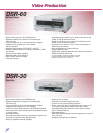
3
The DVCAM Format
Excellent Picture Quality via
Digital Component Recording
The DVCAM format uses 8-bit digital component recording with
a 5:1 compression ratio same as the DV format and a sampling
rate of 4:1:1 to provide excellent picture quality and superb
multigeneration performance.
The DVCAM format is based on an intra-frame compression
scheme which is ideal for editing applications. Based on DCT
(Discrete Cosine Transform) techniques, each frame consists of
10 tracks. Each track has video, audio, ITI (Insert and Track
Information) and sub code areas. ITI, which is a reference
signal used for precise tracking, together with time code on the
sub code area assure highly accurate editing performance.
This technology provides much greater operational flexibility and
facilitates complex multi-layering effects.
High Quality Digital Audio
The DVCAM format also has superior digital audio performance,
with a wide dynamic range and an excellent signal-to-noise ratio
that is comparable to CD quality audio. There are two selectable
audio channel modes: a two-channel mode with 48 kHz/16-bit
recording or a four-channel mode with 32 kHz/12-bit recording.
Playback Compatibility with the DV Format
The DVCAM format is a professional version of the consumer DV
format, maintaining playback compatibility. All DVCAM equipment
is capable of playing back DV recorded* tapes without any
adaptor. A wider track pitch of 15 µm (compared with 10 µm for
consumer DV) gives the DVCAM format higher reliability for
professional editing.
* SP mode only
The DVCAM Format
High-speed Data Transfer
The advanced drum mechanism and SDTI(QSDI™) interface
enable degradation-free data transfer and dubbing at four times
normal speed between the DSR-85 VTR and the Sony ES-7
EditStation™ system, or between two DSR-85 VTRs.
This brings a remarkable reduction in the time-consuming
uploading and dubbing process, without loss of picture and
sound quality.
Versatile Digital Interfaces
•SDTI(QSDI)*
The SDTI(QSDI) is a digital interface which handles compressed
video as well as the sub code data and digital audio signals of
the DVCAM format. It allows virtually degradation-free transfer of
both video and audio signals between DSR Series VTRs that
have an SDTI(QSDI) I/O, and between these VTRs and the
ES-7 EditStation system in a non-linear editing configuration.
The SDTI(QSDI) interface ensures that high quality pictures and
sound are maintained during these operations.
* SDTI (Serial Data Transport Interface) is defined in SMPTE 305M.
SDTI(QSDI) is the DV signal interface which conforms to the SDTI standard.
The DSR-60 and DSR-70 VTRs require optional boards for SDTI(QSDI) operation.
•SDI*
SDI (Serial Digital Interface) is the broadcast standard digital
interface. With just a single digital connection, high quality
pictures and sound can be transferred between DSR Series
VTRs with an SDI I/O, and SDI-equipped devices such as
D-1, Digital BETACAM™ and Betacam SX™ VTRs.
* The DSR-85/80/60/70 require optional boards for SDI operation. These optional
boards support digital component video signals.
•i.LINK™* (DV In/Out)
i.LINK is a digital interface based on the IEEE1394 standard.
It offers digital dubbing of video, audio and data, with virtually no
deterioration of image and sound quality and with the simplicity
of a single wire connection between equipment.
* i.LINK stands for IEEE1394-1995 standards and their revisions. is the logo for
products that implement i.LINK.
** The DSR-70 requires an optional board for i.LINK (DV In/Out) operation.
ClipLink™ Operation
ClipLink is a unique Sony system which conveys shooting data
into the digital production process. During acquisition with the
DSR-130 or DSR-300 Camcorder, the time code data of the
in-point and out-point of each shot is recorded in the Cassette
Memory of the DVCAM tape. At the same time, a still frame of
each in-point, called the ‘Index Picture’, is recorded on the DVCAM
tape to provide visual information associated with the time code.
When a cassette is loaded into the DSR-85, DSR-80, DSR-60 or
DSR-70 VTR interfaced with the Sony EditStation system, all of its
shot log information is loaded into an EditStation system and
appears on the
display.
This visual
information
enables users
to quickly
select the shots
they need to
upload to the
hard disk of an
EditStation.
Unique Technologies and
Tape Direction
Sub Code
Head Direction
Video
Audio
6.35 mm
(1/4 inch)
ITI
ITI: Insert and Track Information
EditStation ES-7 GUI
DVCAM or DV
Cassette Tape
DSR-60
DSR-80
DSR-85
Digital Videocassette Recorder/Player
DSR-130
DSR-300
Digital Camcorder
Scene
No.
1
2
3
Time Code
(IN)
00:01:01
00:05:23
00:18:21
Time Code
(OUT)
00:05:22
00:06:12
00:24:13
Index
Picture
Unique Technologies and
3
DSR-200A
DSR-PD1
DSR-PD100
DSR-30 DSR-20
DRV-1000 DSR-70**
DSR-V10
DSR-85
DSR-85 DSR-80 DSR-60 DSR-70
DSR-85 DSR-80 DSR-60 DSR-70
DSR-130 DSR-300 DSR-85 DSR-80 DSR-60 DSR-70



